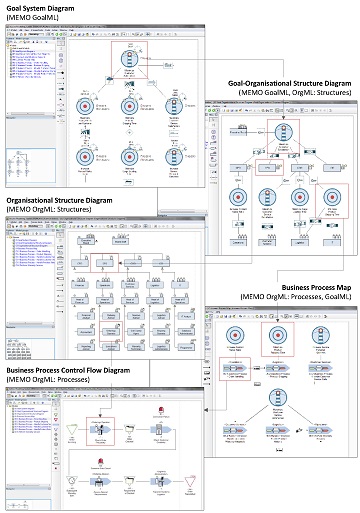Details
Multi-Perspective Enterprise Modeling (MEMO)
MEMO is a method for Multi-Perspective Enterprise Modeling, developed at the Chair of Information Systems and Enterprise Modeling at the University of Duisburg-Essen. MEMO encompasses a set of integrated domain-specific modeling languages (DSMLs) to describe a variety of aspects related to an organization’s action system (including, e.g., goals, organizational structure, and business processes) and information systems (including, e.g., IT infrastructures). Integrative links between the various MEMO modeling languages permit to interrelate model elements from organizational and information-technological areas, enabling to build an integrated, multi-disciplinary view of an organization.
Scope and Purpose of the Tool
The tool MEMO4ADO is one of the most comprehensive enterprise modeling tools available today, implementing subsets of several highly elaborate, integrative, and research-based domain-specific enterprise modeling languages of MEMO. In particular, the current version of MEMO4ADO (1.1) includes six modeling languages (explained below): The MEMO GoalML, MEMO OrgML: Structures, MEMO OrgML: Processes, MEMO ITML, MEMO DecisionML, and MEMO MetricML. Based on these modeling languages, the tool currently provides more than ten diagram types (for a selection, see the figure). The tool is also intended offer an accessible enterprise modeling environment to grasp the notion of multi-perspective enterprise modeling.

The modeling language MEMO GoalML enables to describe organizational goal systems. The language MEMO OrgML: Structures allows to model organizational structures. The language MEMO OrgML: Processes permits to describe business processes. The language MEMO ITML permits to describe IT infrastructures at a high level of detail, covering software elements, hardware elements, and ample additional abstractions (such as communication relationships and service abstractions). The language MEMO DecisionML enables to describe decision processes in the context of an organization, including problem-analytical decision premises, organizational responsibilities, and relationships to IT decision support. The language MEMO MetricML allows to describe and analyze business performance indicators in a reflective fashion, directing attention at the justification and careful interpretation of indicator systems.
For each modeling language, MEMO4ADO provides the ability to create diagrams of specific types (e.g., goal system diagrams using MEMO GoalML; see the left-hand side of the above figure). Furthermore, all modeling languages are integrated and interrelations among diagrams can be expressed by means of references between different diagrams as well as specific integrative diagram types (see the right-hand side of the above figure). More MEMO modeling languages will be added to MEMO4ADO in the future.
How to Start
To start using MEMO and MEMO4ADO, this project page provides you with a variety of resources.
- The tool itself can be downloaded in the Download section.
- To guide you in installing and setting up MEMO4ADO, please consult our Tutorials page.
- The introductory article "Multi-Perspective Enterprise Modeling – Conceptual Foundation and Implementation with ADOxx," included in the OMILAB volume, summarizes the conceptual foundation of MEMO and basic features of the modeling tool MEMO4ADO (see also the Publications section).
- Finally, for more in-depth treatments of the theoretical background of MEMO, details regarding the various MEMO modeling languages, as well as advanced issues of meta modeling, a range of related research publications is found in the Publications section.


